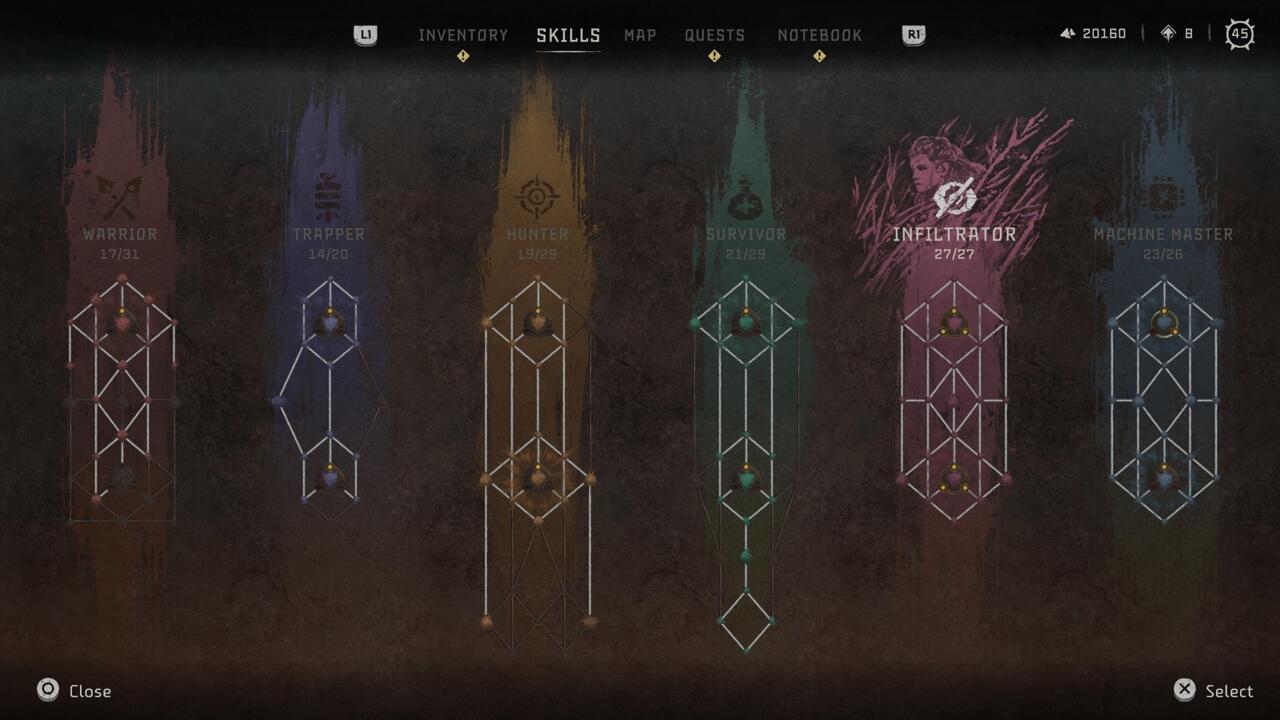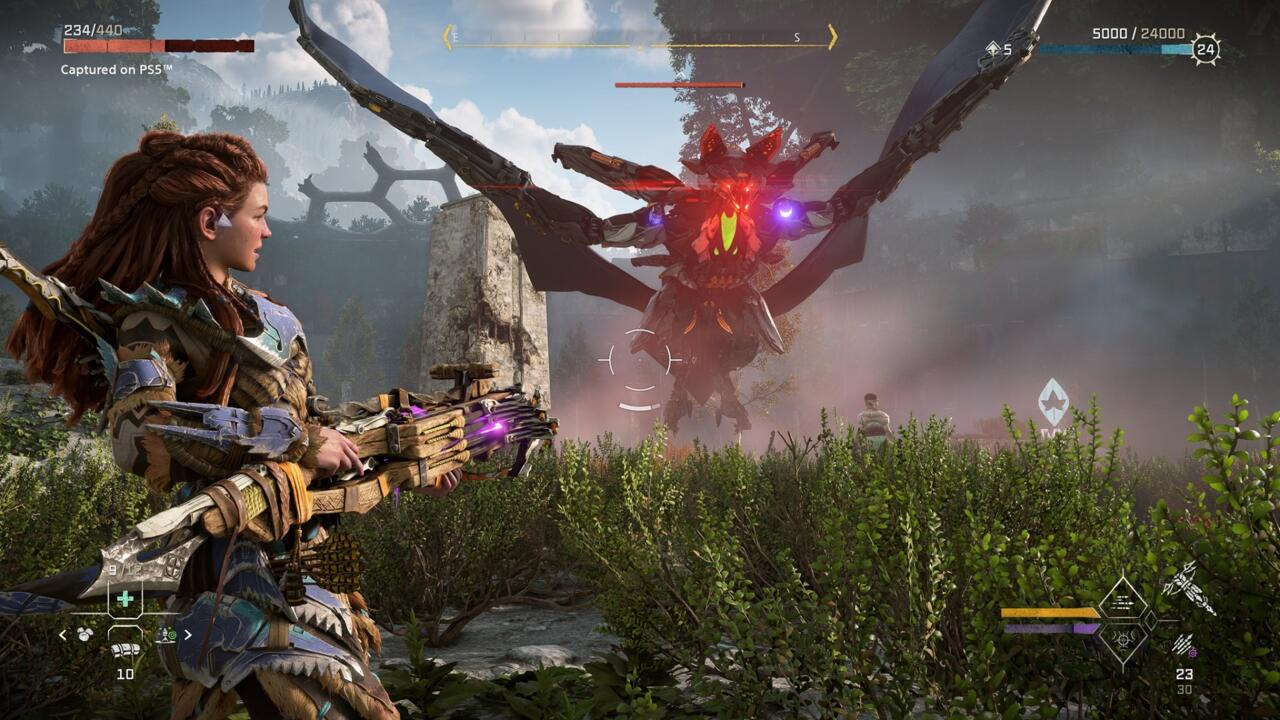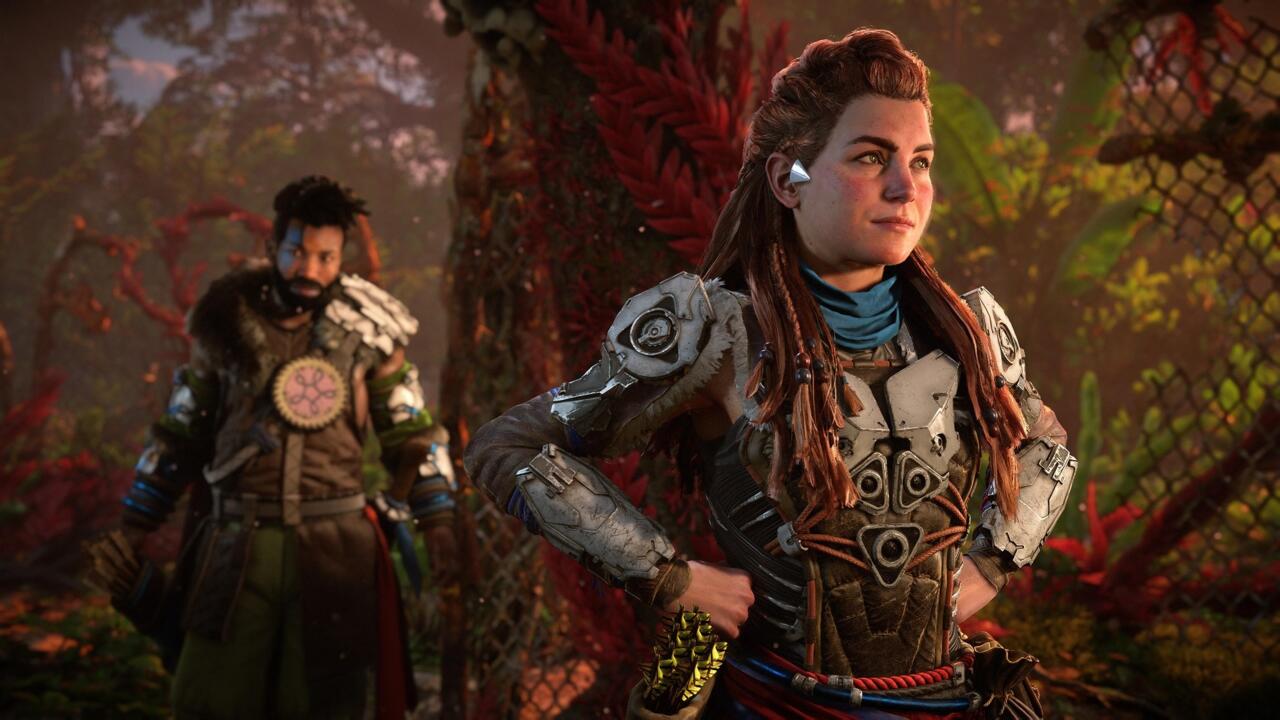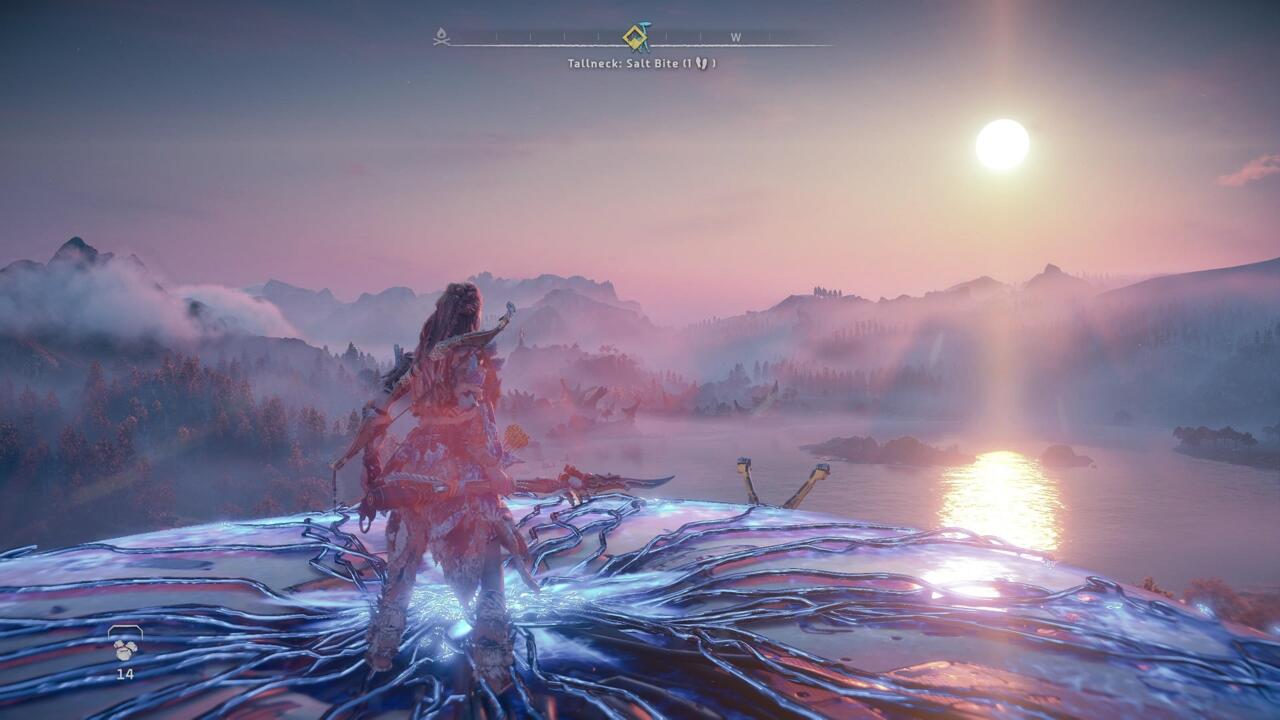Horizon Forbidden West can be daunting in its size and scope. That feeling only grows as you uncover its map, collect gear to fill in its giant arsenal of weapons and armors, or unlock a huge number of special moves, skills, and passive buffs from its expansive, revamped skill tree. But while it casts an imposing shadow, Forbidden West often keeps its focus on characters and their stories, and that approach works to break the enormity into smaller chunks and give your adventure stakes that matter. The game is continually compelling not because developer Guerrilla Games filled it with a huge amount of stuff to do, but because so much of that stuff is thoughtfully constructed and sometimes even emotionally engaging, instead of just feeling like items created to add as many map markers to the world as possible.
Forbidden West picks up almost immediately after the end of its predecessor, Horizon Zero Dawn, and its DLC add-on, Frozen Wilds, and it expects you to be very familiar with protagonist Aloy's adventures from back in 2017. It's set in the distant future after the world as we know it has ended and humans have reverted to a tribalistic society scattered across the ruins of the United States. And roaming all around the world are giant robotic animals, some as big as dinosaurs, that kill humans on sight.
The big issue driving the action is that, although Aloy defeated the rogue artificial intelligence Hades in the last game, it left lasting damage to the planet's biosphere. Aloy is hunting for ancient tech to fix the problem and stop a blight that's creeping across the land, threatening everyone with slow starvation, and the search takes her into the Forbidden West. A whole bunch of major and minor players from Zero Dawn are involved in some way or another, including Sylens, the semi-antagonistic voice on Aloy's radio throughout the first game, and it's easy to get a little lost in exposition and dialogue if you're not up on all the events, relationships, and machinations that took place in Forbidden West's predecessor.
Since Aloy is a hunter in a hunter-gatherer society, collecting components to craft gear is a huge part of the experience, both for improving your equipment and for keeping you stocked for battle. Part of what makes you so effective in the Horizon games is Aloy's Focus, a remnant of old-world technology that allows her to interface with computers, see things others can't, and gather information on enemies. Combat is all about spotting machine weak points and using various kinds of weapons and crafted ammo to strip away armor, while inflicting status effects such as setting enemies on fire, bathing them with corrosive acid, or freezing them to make their metal bodies brittle.
In a lot of ways, Forbidden West is pretty much the same as Zero Dawn, but it follows the common sequel ethos of "more and bigger," and a lot of the systems have been improved and expanded. The Horizon games include climbing and environmental puzzles like those you'd see in Assassin's Creed or Uncharted, but more of Forbidden West's world is scalable than in Zero Dawn, allowing you to reach the tops of mountains or ruins--although this isn't The Legend of Zelda: Breath of the Wild, and there are still plenty of things you can't climb. The freedom still improves traversal quite a bit, however, as does a powered grapple that you can use to reach specially marked points, a glider that lets you get down from those high places quickly, and the ability to swim and explore submerged environments.
Your arsenal is larger, with a host of different kinds of weapons and elemental ammo types for straight combat, plus a series of craftable traps that you can use to take down machines and enemies before they spot you. There's so much it can be hard to keep straight, in fact. You get various bows, slingshots, and launchers, ammo for all of them that deliver different elemental status effects, plus traps of various types and effectiveness. You can craft ammo on the fly in combat if you have the pieces you need, whether it's regular arrows, freezing bombs, or explosive javelin spikes, and all of your many weapons are upgradeable if you have the right components. It all incentivizes you to scan every robot for useful pieces, dig through every heap of salvaged metal, and open every thousand-year-old tackle box in case you might need what's inside.

Six huge skill trees replace Zero Dawn's much more modest four, each focused on a single element of Aloy's arsenal, such as trapping, hacking, ranged combat, or stealth. The skills you can unlock include passive buffs and active special moves that correspond to specific weapon types. There's also a new set of Valor abilities for Aloy that are similar to the "ultimates" you might see in something like Overwatch or Apex Legends. One Valor ability lets you turn on active camouflage to go invisible and escape a bad situation; another amps up your ability to slice off machine parts with your weapons; a third just creates a blast of electricity around you to send enemies flying. You can only equip one Valor ability at a time once you've unlocked it, and you have to charge it up through combat in order to use it.
Again, it is a lot of stuff to keep track of, and the sheer volume works against Forbidden West as often as it works for it. Most of the time, though, it's not super clear whether the Uncommon Shredder launcher a merchant is selling is an upgrade over the Uncommon Shredder launcher you already have--lots of weapons have similar stats, or one will offer acid ammo instead of fire ammo, making the decision between them feel overly granular and not particularly important. The limits on how much stuff you can carry are pretty high, so you'll quickly end up with lots of slightly different weapon variations. With so many ammo types in the game, you wind up just carrying a bunch of weapons to cover all the elemental bases, while not really caring about any of them. It's only late in the game, when you start to find some demonstrably sick weapons, that the arsenal feels like anything more than just a pile of junk in your backpack you have to dig through until you find a bow that shoots the right kind of arrows for a given situation.
The massive skill tree presents the same problem. Valor abilities can be great in a pinch, giving you some next-level power when you really need it, but there are two to unlock on each skill tree and the use cases for some aren't nearly as clear as "emergency invisibility cloak" or "30 seconds of souped-up arrows." The same goes for the huge number of special abilities, which amounts to three for each weapon type. Some are game-altering strategy centerpieces, like the Knock-Down Shot, but others are easy to forget about, like a skill that makes your slingshot bomb more powerful if it bounces on the way to your target. With both skill and Valor abilities, you'll probably unlock one or two you like and stick with those for most of the game.
That's also an issue with the flow of combat. Forbidden West gives you more options in a fight, but it doesn't really change battles fundamentally from Zero Dawn. It just throws more ingredients into the stew. You'll usually sneak into a situation where a bunch of robots or humans are gathered, moving from tall grass patch to tall grass patch to either set traps, snipe enemies, or pull off sneaky executions. Once you've tipped off the machines to your presence, though, combat can feel flaily. Enemies have a tendency to attack quickly and relentlessly, and your only defensive recourse is a dodge roll to get out of harm's way, since melee combat remains mostly a hit-and-run option that's not especially satisfying. So when a Scrapper or a Widemaw charges, you're dodging attack after attack, hoping to get a little distance to draw an arrow and get a shot off before you go back to fleeing for your life.

It's also frustrating trying to dig through your (other) stupidly large bag of traps and potions to find an item that can heal you or cancel status effects as, again, you're being chased down by an apartment building-sized predator. It's worth noting that you can customize that bag to lessen the options in it--something that is essential if you want to find something important in the heat of the moment--but it doesn't change the fact that Aloy has so much gear and so many options that a lot of Forbidden West's good ideas about combat, stealth, trapping, and crafting get in the way of each other.
But when you're able to make Aloy's various tools and abilities come together, it creates some harrowing and exciting battles. That's especially true when you're able to make a plan with stealth, traps, and tactics, and execute that plan. It helps that, while you'll fight a lot of battles alone, quite a few encounters will see you aided by other characters. Having an extra bow and more targets for machines to chase lessens the pressure, and characters routinely chuck Aloy extra ammo to keep the fight going.
And really, it's those other characters that will keep you going through Forbidden West as much as the opportunity to explore a fascinating ruin or fell a rampaging robo T-rex. Often you'll meet up with someone from a local tribe who has a vested interest in checking out that long-dormant agricultural testing facility or space travel research lab, and it's in building relationships with these characters and learning about their various peoples that Forbidden West really shines.
While Aloy herself is kind of dull--she's like Batman if he wasn't also Bruce Wayne, just somberly wandering around thinking about the next death-defying action she has the duty to undertake, all while speaking out loud every little thing she thinks--Forbidden West puts her in an almost Mass Effect-style position of building a team of people to help her save the world. About a third of the way into the game, you establish a stable base of operations, and characters both old and new become mainstays. You don't bring them out into the field as a unit like an RPG team, but you can head back to talk with them about what you learn and your experiences, and they'll often pair up with you at key moments or ask your help with side quests that are important to them. The group grounds Forbidden West's story by making it feel more personal, while giving you a reason to care about what's happening in local events.
Side quests, too, are populated by interesting people with relatable problems and motivations, and Forbidden West does a great job of giving you things to do that don't feel like repetitions of the open world "go here, get this" quest template. Often, side quests involve several steps or multiple missions, forcing Aloy to intervene in local politics or help with dire situations. In one series of missions, you wind up interacting with the leaders of two desert villages, each with differing views about the future of the larger tribe and distrusting the other. Both are likable but flawed characters, and as you spend a little time helping and getting to know them, you realize that neither is wholly right or wrong. When you're ultimately forced to try to mediate their dispute or choose a side, the time you've spent keeps you invested in the situation's resolution and makes your involvement in it feel important.

Forbidden West is full of moments like this, where the game goes out of its way to put you in close contact with a side character for a bit, and then turns them into the fulcrum of a compelling quest. Paired with the stakes of the overall main story, this gives the whole game the feeling that you're not just running around doing errands for people; you're actually building important relationships with people you've come to know and respect. And while there are an absolute truckload of side quests, plus smaller jobs to do, the fact that so many are so well-written or offer a deeper look into Forbidden West's world makes them all worth doing.
Guerrilla is usually also good at keeping its various map-filling activities feeling fresh and diverse. The game contains a number of "relic ruins" sites, in which you explore a decrepit ancient building looking for an artifact locked in a hard-to-reach place. There are a bunch of these, but I stopped to do each one because they're fun and complex climbing puzzles that are all very distinct from the others. The same goes for the Tall Necks, the giant robot dinosaurs that serve the map-revealing function of towers in other open-world games. Reaching the top of each lumbering robot is a puzzle unto itself; one is submerged in the ocean and requires you to find components to rebuild it, for instance, and another can't be reached until you knock it over by shooting giant ballistas at it. The general goal is always to get to the top of a Tall Neck, but each challenge is so different from the others that they're absolutely worth chasing down as soon as you reach a new area.
The main story also has its share of standout moments. One portion concerns helping the leader of the Tanakth tribe to put down a rebellion so he can make attempts at peace and cooperation with the eastern tribes. Another takes you into a submerged underground Las Vegas strip to help some salvagers realize their dream of elevating their traveling storytelling act with technological wonders. The story can be uneven at times, but it's often good at keeping the focus on smaller-scale stakes that feel like they actually matter to the people involved.
The storytelling is aided by the fact that Forbidden West is absolutely gorgeous on PlayStation 5, in both its graphics-focused or performance-focused modes. Everything, from the characters and their intricately constructed armor, to the rusting ruins of cities with rebar jutting out of concrete, to the lush jungles and wind-swept deserts, is impressively detailed. Catching a sunrise over the farms of Plainsong or the waves of Landfall is legitimately beautiful, and the colorful, diverse locations offer vista after stunning vista everywhere you look. It's a very pretty game.

Characters, meanwhile, benefit from a great deal of strong voice work and what seems like an abundance of scanned facial performances, if not outright full motion capture. You'll spend a large amount of time in conversations in Forbidden West, and in the main quest and big side quests, the characters are often compelling because their facial performances are so good. This has a drawback, though--you'll definitely notice the less-important folks who move like animatronics, and in some interactions on lesser missions, Aloy has a tendency to look all over the place, as if her animation isn't quite matched to that particular conversation or circumstance. For the big and important moments, though, a ton of characterization and emotion comes through in the faces, and it makes the stories and emotional beats of the game all the more interesting.
The vast size of Forbidden West also feels like it introduces a fair few technical issues beyond Aloy's occasional inability to make eye contact with less-interesting characters. Especially when you're on a mount or looking over large distances, there can be some texture pop-in, particularly with the architecture of settlements. The game crashed to the PlayStation dashboard on me a few times as I played through it, and once or twice, a quest couldn't be completed until I reloaded an earlier save. Aloy got stuck looting a chest or an enemy a few times, forcing me to roll back to an earlier save. While these issues sound frustrating, they were spread over dozens of hours and only ever ended up being a minor inconvenience thanks to Forbidden West's liberal autosaves, so I never lost much, if any, progress. A day one patch seems to have ironed out a few of the pre-release issues I experienced, but while some have been lessened, like the texture pop-in problem, they haven't been eliminated.
Overall, though, Horizon Forbidden West does a lot more right than it does wrong. It might be jam-packed with stuff to see, do, know, and remember, but when its many systems come together, it can be a beautiful, exciting, and delightful open-world experience. The story that drives you through the frontier is often well-told and does well to center actual characters rather than audio logs, and while the map is littered with icons, it's much more often that they're fun, skillfully crafted diversions than random busywork to fill a checklist. There's a huge amount to do and see in Horizon Forbidden West, and the great majority of it is worth doing and seeing thanks to strong writing, great visuals, and some marked improvements to the series' underlying ideas.









